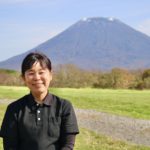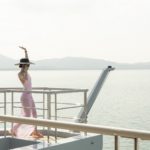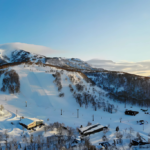Confession: We’re very open about our love of Niseko, but we’ve been hiding something – Niseko isn’t our only ski time love. We’ve been low-key obsessed with another Japanese ski town for a while now – Hakuba.
No, we haven’t been hiding Hakuba out of shame or fear that everyone would suddenly discover it (1998 was kind of a big year for Hakuba). It’s a bit more like we wanted to pretend like the region was our dirty little secret. Well, we’re finally ready to start talking. So, to get you more acquainted with the region, here are some of the reasons we love disappearing into Hakuba and why you’ll love it too!
#1 The Slopes

In the heart of the Japanese Alps, Hakuba is one of Japan’s top winter resort areas. Consisting of nine (!) major resorts stretched across a valley, the area offers the most varied terrain, vertical rise and advanced slopes in all of Japan. The resorts are all easily accessible from the towns of Happo and Wadano.
Plus, being in the Alps, it gets some of the country’s best snowfalls. The annual base of snow exceeds ten metres! And yes, the snow quality is just as fluffy as that of Niseko!
With 135 lifts and over 200 different trails, it’s an absolute playground for skiers and snowboarders who want a bit more of a challenge and has miles of easier trails for beginners.
#2 The Accessibility

Hakuba is super easy to get to! If you’re going directly from Narita, you can hop straight onto a bus or taxi to get you there. As well, there are actually services that will take your bags straight to Hakuba from Narita for you (hooray to not having to drag your luggage around and around!). Alternatively, you can catch the Shinkansen bullet train from Tokyo Station. Hakuba is perfect if you’re holidaying in Tokyo or anywhere else along the bullet train route.
Note: the buses can take up to 6 hours from Narita, and the bullet train is a 3.5-hour journey from Tokyo.
Read also: The first-timers Niseko guide: 10 things to know when planning your ski trip
#3 The Olympic Dream

So, you remember the above 1998 comment? If you haven’t recalled the significance yet, then you’re probably not big on the Olympics (no judgement – they’re a long two weeks).
Well, Hakuba (Happo-One Resort to be exact) hosted the slopeside events that year! So, if you’ve ever wanted to feel like a champion (beyond just being you, obviously), Hakuba is the place to go, fly down a mountain-side at full speed, and live out some childhood dreams.
#4 The FOOD!

The food, the food, the food! Nagano, the region in which Hakuba is located, is the home of soba noodles. Between the fresh mountain water and fertile ground, the area’s positioning in the Japanese highlands makes it ideally suited for growing the buckwheat that creates soba. Eat all the soba you can there!
It’s not just soba that the mountain water is good for either. The vegetables and meats that you’ll eat when staying in Hakuba come almost exclusively from the area, so everything is fresh and super tasty! Restaurants there serve everything from Western comfort food to regional delicacies like oyaki (a type of Japanese dumpling), nozawana-zuke (picked mustard leaves), basashi (raw horse meat – no further comment from us), and shichimi togarashi (a spice blend you won’t find anywhere else).
Read also: In Season: Hakuba in the Japanese Alps
#5 The Family-Friendly Amenities

The kids’ scene in Hakuba is spectacular. We particularly love the kid-friendly space at the area’s Happo-One resort.
Within Happo-One there are two different kids’ parks where children can get started with skiing, go sledding and tubing, and play around building snowmen and getting into snowball fights! There is also the Pre-school MA’AM Club nursery that cares for kids who are over the age of 3 months so you can head out on the slopes with no fear of the children creating mass havoc. As well, there is a free Kids’ Space at the top of a gondola where kids can take a break, nap and play.
Additionally, there are separate “Sakka Debut” lift tickets so that kids can practice carving in a designated beginners area without having to pay for access to the entire resort.
#6 The Apres-Ski Scene

If you’re not there with kids or are happy to leave them with a sitter, then you need to get on top of the Hakuba apres-ski scene. Hakuba may not have as many options as places like Niseko, but it gets lit!
Echoland Village, which sits between Happo-One and Hakuba 47 resorts is the place to be in Hakuba. Bars in the area range from the more reserved Japanese-style to the super raucous Australian pub. And there are a fair few night clubs.
Read also: Travel journal: Australian model Natalie Roser in Hakuba
#7 The Rejuvenation

One of our favourite things to do at the end of a long ski day in Japan is to journey to the nearest onsen and soak. With four separate hot springs sending its waters through the Hakuba Valley there is an almost infinite number of onsens in the area to choose from. If you don’t have one in your accommodation, you’ll easily find a public onsen near the ski resorts!
#8 The Snow Monkeys

Jigokudani Park is one of the few places in the world where you can watch snow monkeys bathe in hot springs. The park is a good day trip from Hakuba, but the monkeys are a must-see – perfect for a skiing off-day.
You should be aware though that the hot springs are about a 25-minute walk from the park entrance, so you’ll need to have appropriate footwear. The walk is worth it, even if your legs are weary – the park is stunning!
#9 The Historical Sites

Day trip opportunities galore! Something that Hakuba has on Niseko is the area’s history. There are some truly beautiful cultural relics in the Nagano area, like Matsumoto Castle and Zenkoji Temple.
Matsumoto Castle is one of Japan’s most important historical sites – it’s one of the oldest standing castles in the country! Called “The Crow Castle” because of its black colour, it’s one of the rare castles built on an open plain rather than a hill or mountain (warring parties liked having a high viewpoint). It’s also one of the best-preserved sites in Japan with its wooden interior. There is none of that concrete stuff to keep it standing! Then, at the centre of Nagano, you’ll find Zenkoji Temple which stores what is believed to be Japan’s first ever Buddhist statue.
Oh, and then there are all of the area’s museums, like the Zenkoji History Museum and the Omachi Mountain Museum. The history buff in you will adore the ample opportunities to explore Japan’s culture.





